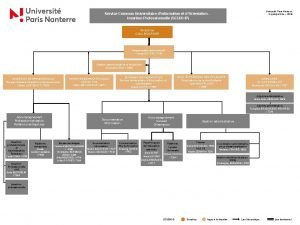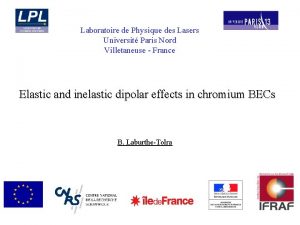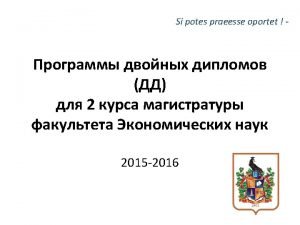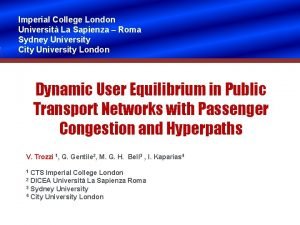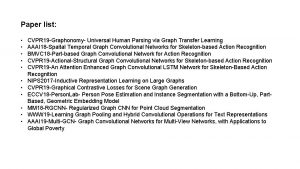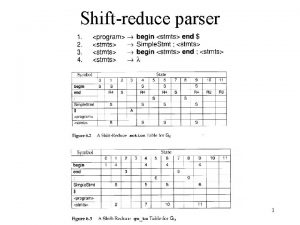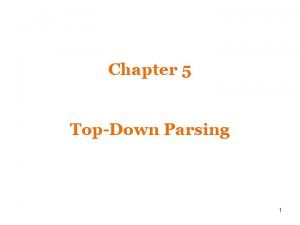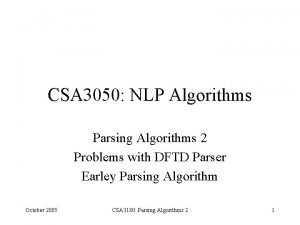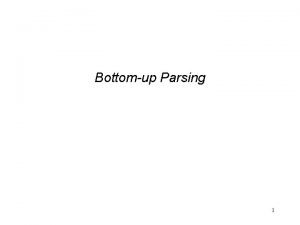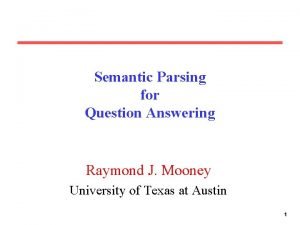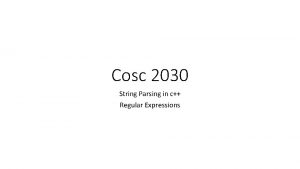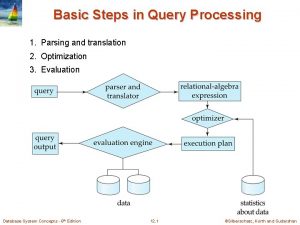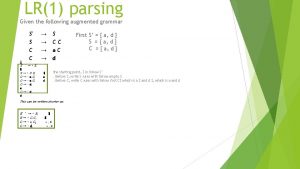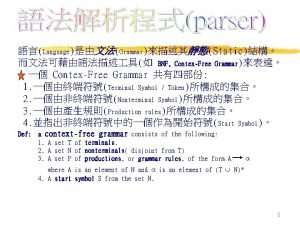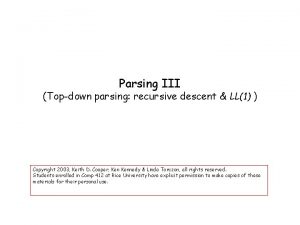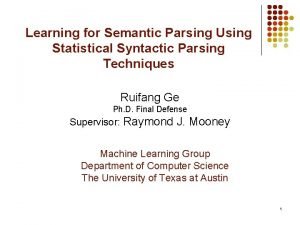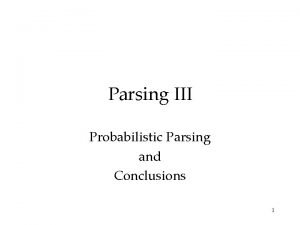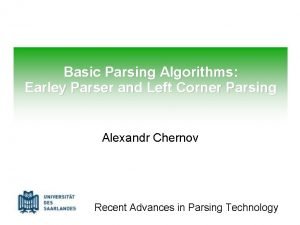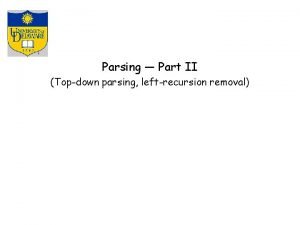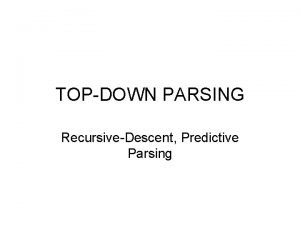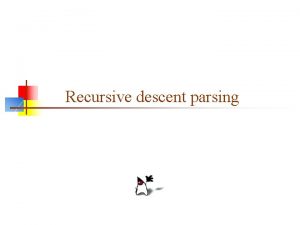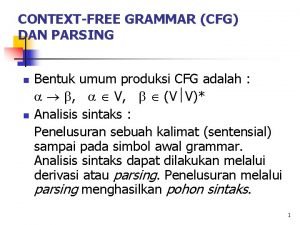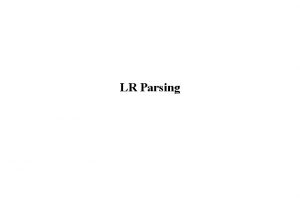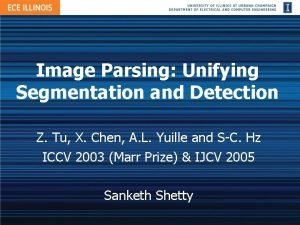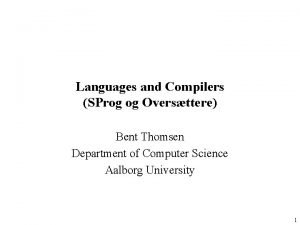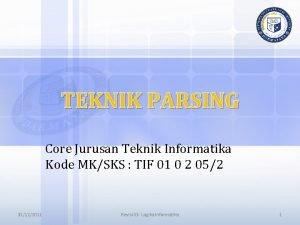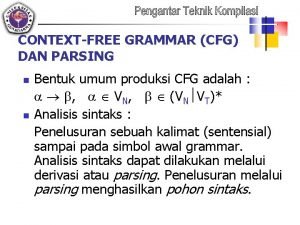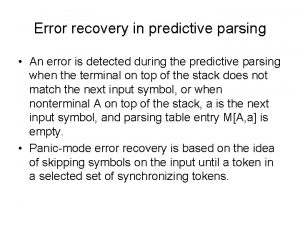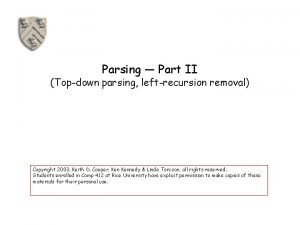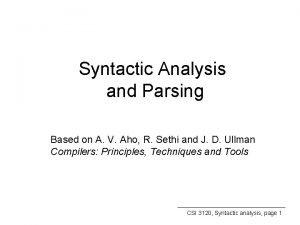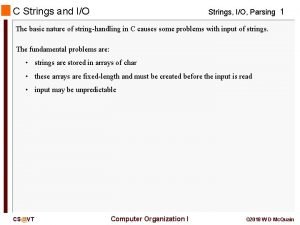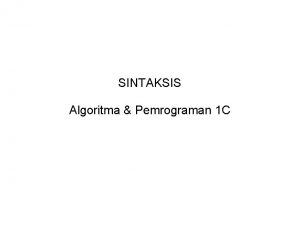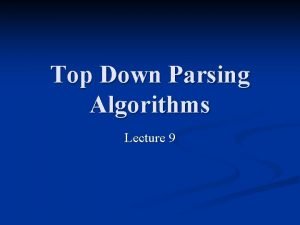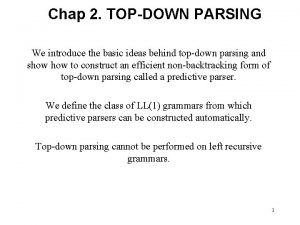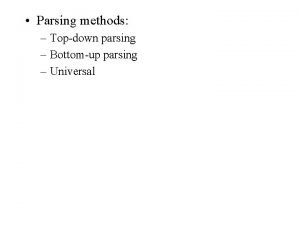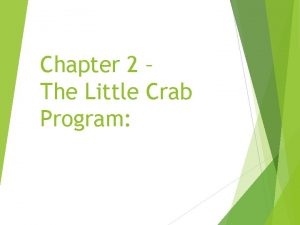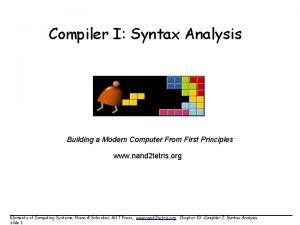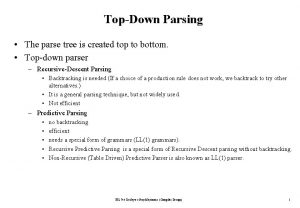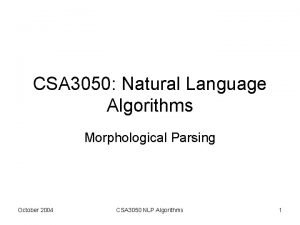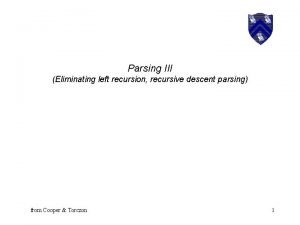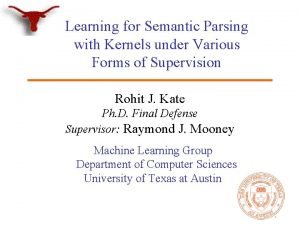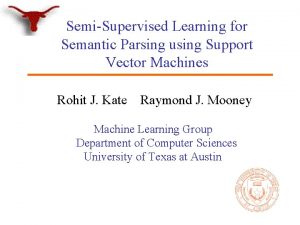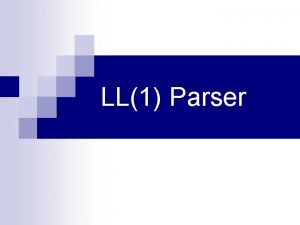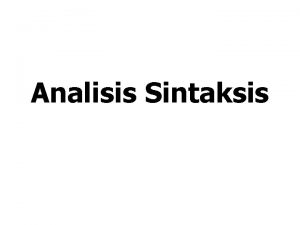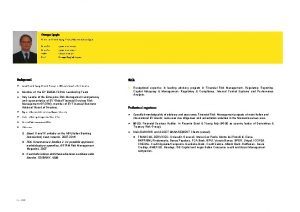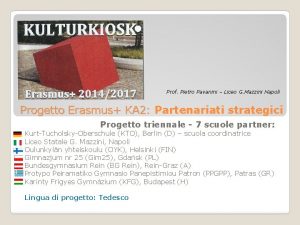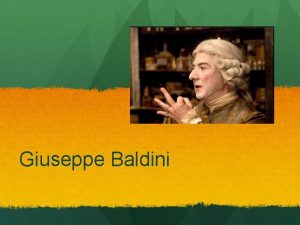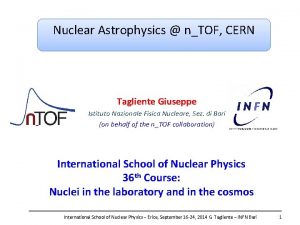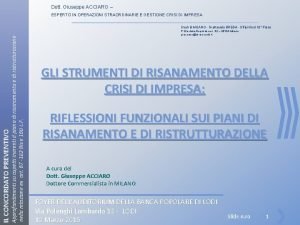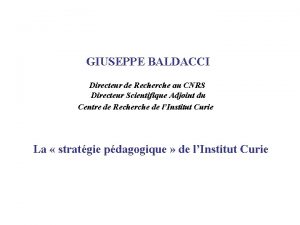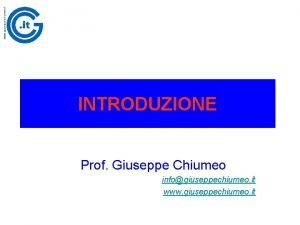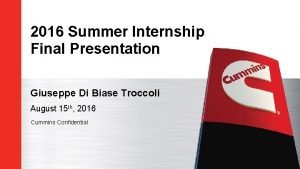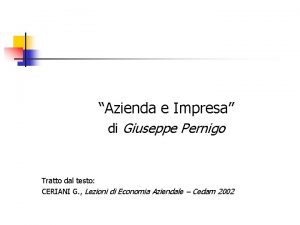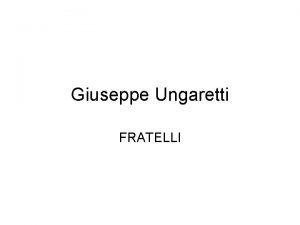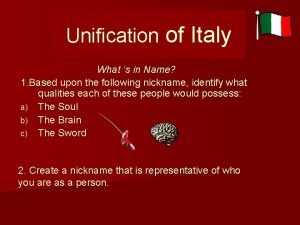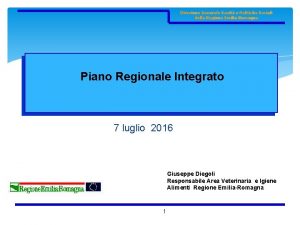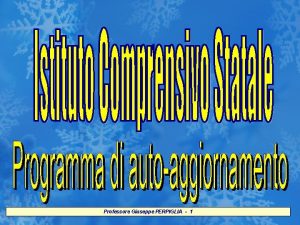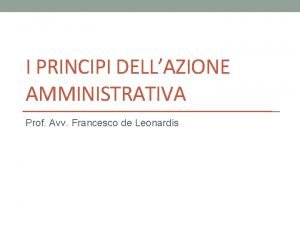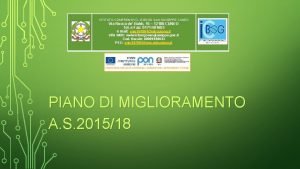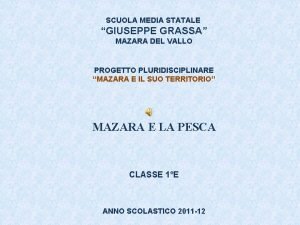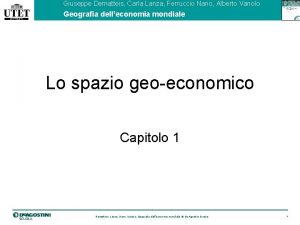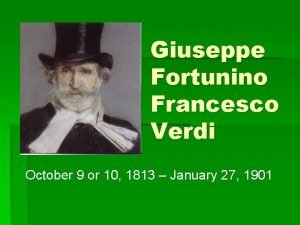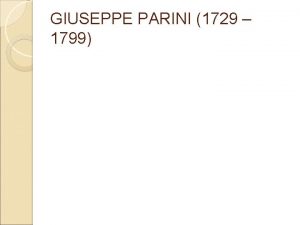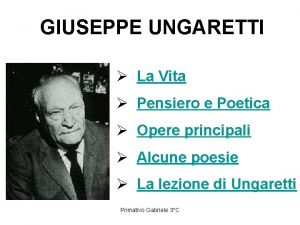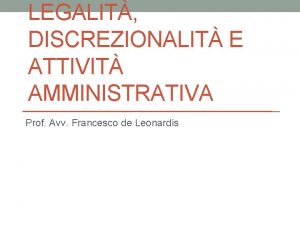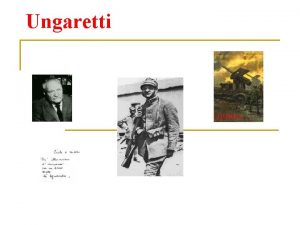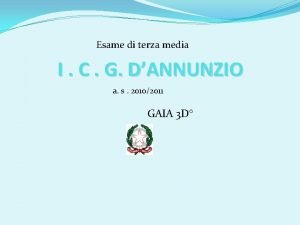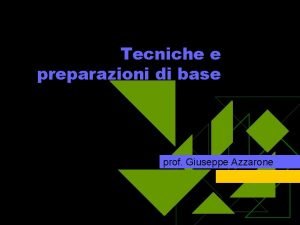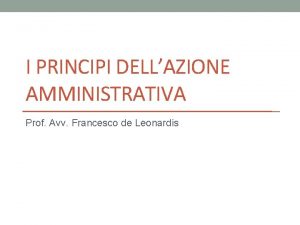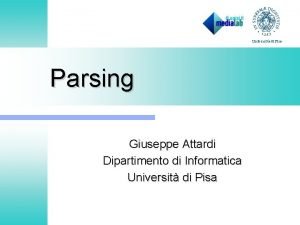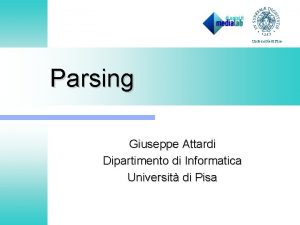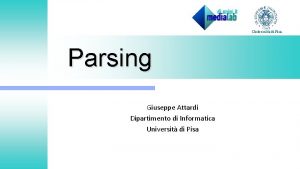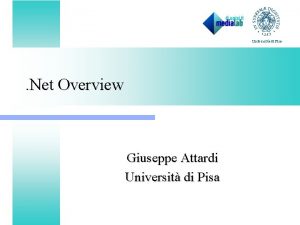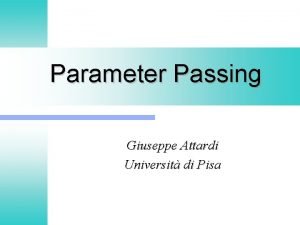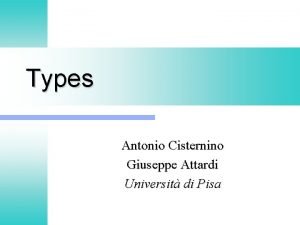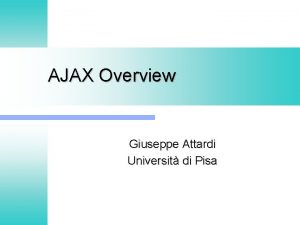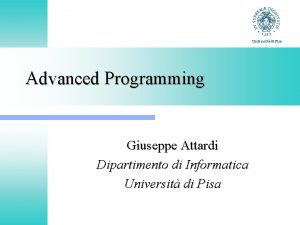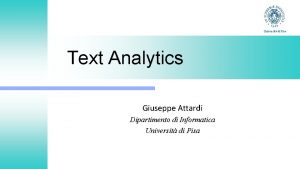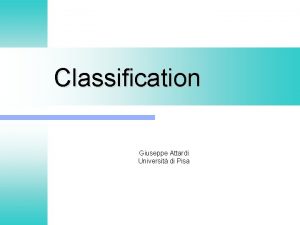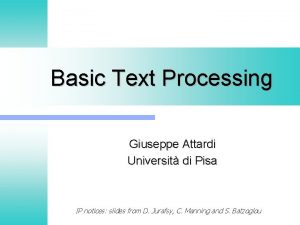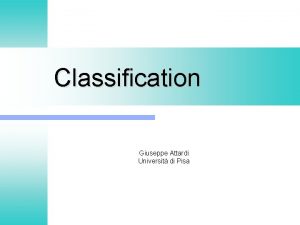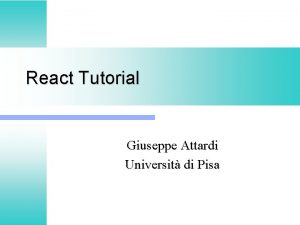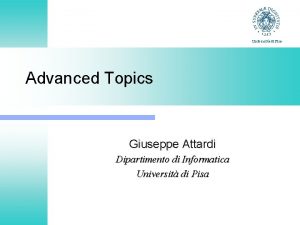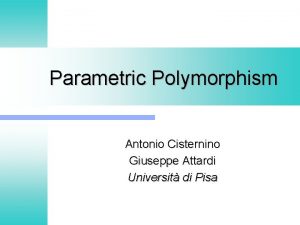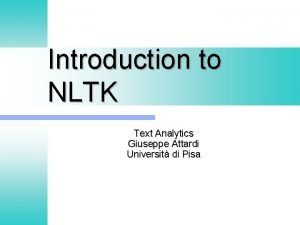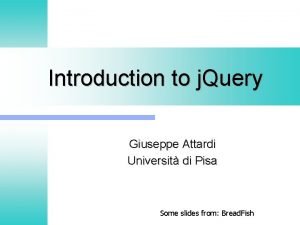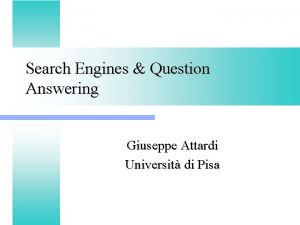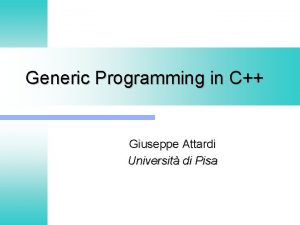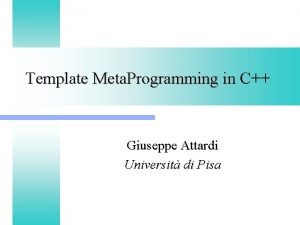Parsing Giuseppe Attardi Universit di Pisa Parsing To




























































![Recursive Descent Parser stat → var = expr ; expr → term [+ term] Recursive Descent Parser stat → var = expr ; expr → term [+ term]](https://slidetodoc.com/presentation_image/596a2aabc18cf12758141b77fb50e335/image-61.jpg)








![Expr // expr : : = term ['+' term] private Expr expr() throws … Expr // expr : : = term ['+' term] private Expr expr() throws …](https://slidetodoc.com/presentation_image/596a2aabc18cf12758141b77fb50e335/image-70.jpg)
![Term // term : : = factor ['*' term ] private Term term() throws Term // term : : = factor ['*' term ] private Term term() throws](https://slidetodoc.com/presentation_image/596a2aabc18cf12758141b77fb50e335/image-71.jpg)







![Example { "name": { "first": "John", "last": "Doe" }, "age": 23, "children": ["Paul", "Mary"] Example { "name": { "first": "John", "last": "Doe" }, "age": 23, "children": ["Paul", "Mary"]](https://slidetodoc.com/presentation_image/596a2aabc18cf12758141b77fb50e335/image-79.jpg)









![Language Classes L 0 CSL CFL [NPA] LR(1) LL(1) RL [DFA=NFA] Language Classes L 0 CSL CFL [NPA] LR(1) LL(1) RL [DFA=NFA]](https://slidetodoc.com/presentation_image/596a2aabc18cf12758141b77fb50e335/image-89.jpg)



- Slides: 92

Parsing Giuseppe Attardi Università di Pisa

Parsing To extract the grammatical structure of a sentence, where: sentence = program words = tokens For further information: Aho, Sethi, Ullman, “Compilers: Principles, Techniques, and Tools” (a. k. a, the “Dragon Book”)

Outline of coverage l Context-free grammars l Parsing – Tabular Parsing Methods – One pass • Top-down • Bottom-up l Yacc

Grammatical structure of program function-def name arguments main () stmt-list stmt expression operator expression variable << string cout “hello, worldn”

Context-free languages Grammatical structure defined by contextfree grammar statement assignment ; statement expression ; statement compound-statement assignment ident = expression compound-statement { declaration-list statement-list } Definition (Context-free). Grammar with only one non -terminal symbol in left hand side of productions. Symbols terminal (token) non-terminal

Context Free Grammar G = (V, S, P, S) l V is a finite set of non-terminal symbols l S is a finite set of terminal symbols l P is a finite set of productions V (V S)* l S is the start symbol

Parse trees Parse tree: tree labeled with grammar symbols, such that: if node is labeled A and its children are labeled x 1. . . xn, then there is a production A x 1. . . xn l “Parse tree from A” = root labeled with A l “Complete parse tree” = all leaves labeled with tokens

Parse trees and sentences Frontier of tree = labels on leaves (in left-to -right order) l Frontier of tree from S is a sentential form l Definition. A sentence is the frontier of a complete tree from S. L E a L ; E “Frontier”

Example G: L L ; E | E E a | b Syntax trees from start symbol (L): L E a L L ; E E L L E a L ; E ; b E b a Sentential forms: a a; E a; b; b

Derivations Alternate definition of sentential form: l Given , in V*, say is a derivation step if ’ ’’ and = ’ ’’ , where A is a production l is a sentential form iff there exists a derivation (sequence of derivation steps) S (alternatively, we say that S * ) Two definitions are equivalent, but note that there are many derivations corresponding to each parse tre

Another example H: L E ; L | E E a | b L L E ; L E a L E ; a L E b ; L E b

Ambiguity A sentence can have more than one parse tree l A grammar is ambiguous if there is a sentence with more than one parse tree l Example 1 E E+E | E*E | id l E E E + E id E * id E E id id E * E + E id id

Notes l If e then if b then d else f l { int x; y = 0; } l a. b. c = d; l Id -> s | s. id E -> E + T + T -> id + T -> id + T * id + T -> id + id * id + id

Ambiguity l Ambiguity is a feature of the grammar rather than the language l Certain ambiguous grammars may have equivalent unambiguous ones

Grammar Transformations l Grammars can be transformed without affecting the language generated l Three transformations are discussed next: – Eliminating Ambiguity – Eliminating Left Recursion (i. e. productions of the form A A ) – Left Factoring

Eliminating Ambiguity Sometimes an ambiguous grammar can be rewritten to eliminate ambiguity l For example, the grammar of Example 1 can be written as follows: l E E +T | T T E * id | id The language generated by this grammar is the same as that generated by the previous grammar. Both generate id(+id|*id)* l However, this grammar is not ambiguous l

Eliminating Ambiguity (Cont. ) l One advantage of this grammar is that it represents the precedence between operators. In the parsing tree, products appear nested within additions E E T id + T T * id id

Eliminating Ambiguity (Cont. ) l An example of ambiguity in a programming language is the dangling else l Consider S if then S else S | if then S |

Eliminating Ambiguity (Cont. ) l When there are two nested ifs and only one else. . S if b then S S else if b then S a S if b a S then if b then S a else S a

Eliminating Ambiguity (Cont. ) In most languages (including C++ and Java), each else is assumed to belong to the nearest if that is not already matched by an else. l This association is expressed in the following (unambiguous) grammar: l S Matched | Unmatched Matched if then Matched else Matched | Unmatched if then S | if then Matched else Unmatched

Eliminating Ambiguity (Cont. ) l Ambiguity is a property of the grammar l It is undecidable whether a context free grammar is ambiguous l The proof is done by reduction to Post’s correspondence problem l Although there is no general algorithm, it is possible to isolate certain constructs in productions which lead to ambiguous grammars

Eliminating Ambiguity (Cont. ) l For example, a grammar containing the production A AA | would be ambiguous, because the substring has two parses: A A A l A A A a a a A A A a a This ambiguity disappears if we use the productions A AB | B and B a or the productions A BA | B and B a.

Eliminating Ambiguity (Cont. ) l Examples of ambiguous productions: A A A | A A l A CF language is inherently ambiguous if it has no unambiguous CFG – An example of such a language is L = {aibjcm | i=j or j=m} which can be generated by the grammar: S AB | DC A a. A | C c. C | B b. Bc | D a. Db |

Elimination of Left Recursion l A grammar is left recursive if it has a nonterminal A and a derivation A + A for some string – l Top-down parsing methods cannot handle leftrecursive grammars, so a transformation to eliminate left recursion is needed Immediate left recursion (productions of the form A A ) can be easily eliminated: 1. Group the A-productions as A A 1 | A 2 | … | A m | 1| 2 | … | n where no i begins with A 2. Replace the A-productions by A 1 A’ | 2 A’ | … | n. A’ A’ 1 A’ | 2 A’| … | m. A’ |

Elimination of Left Recursion (Cont. ) l The previous transformation, however, does not eliminate left recursion involving two or more steps l For example, consider the grammar S Aa | b A Ac | Sd | e S is left-recursive because S Aa Sda, but it is not immediately left recursive

Elimination of Left Recursion (Cont. ) Algorithm. Left recursion elimination. Arrange nonterminals in some order A 1, A 2 , , …, An for i = 1 to n { for j = 1 to i - 1 { replace each production of the form Ai Aj by Ai d 1 | … | dn where Aj d 1 |…| dn are the current productions for Aj } eliminate the immediate left recursion among the Aiproductions }

Elimination of Left Recursion (Cont. ) Notice that iteration i only changes productions with Ai on the left-hand side, and Aj with j > i in the right-hand side l Correctness induction proof: l – Clearly true for i = 1 – If true for all i < k, then when the outer loop is executed for i = k, the inner loop will remove all productions Ai Aj with j < i – Finally, after the elimination of self recursion, m in any Ai Am productions will be > i l At the end of the algorithm, all derivations of the form Ai + Am will have m > i and therefore left recursion will not be present

Left Factoring Left factoring helps transform a grammar for predictive parsing l For example, if we have the two productions S if then S else S | if then S on seeing the input token if, we cannot immediately tell which production to choose to expand S l In general, if we have A 1 | 2 and the input begins with , we do not know (without looking further) which production to use to expand A l

Left Factoring (Cont. ) l However, we may defer the decision by expanding A to A’ l Then after seeing the input derived from , we may expand A’ to 1 or to 2 l Left-factored, the original productions become A A’ A’ 1 | 2

Non-Context-Free Language Constructs l Examples of non-context-free languages are: – L 1 = {wcw | w is of the form (a|b)*} – L 2 = {anbmcndm | n 1 and m 1 } – L 3 = {anbncn | n 0 } l Languages similar to these that are context free – L'1 = {wcw. R | w is of the form (a|b)*} (w. R stands for w reversed) This language is generated by the grammar S a. Sa | b. Sb | c – L'2 = {anbmcmdn | n 1 and m 1 } This language is generated by the grammar S a. Sd | a. Ad A b. Ac | bc

Non-Context-Free Language Constructs (Cont. ) l L''2 = {anbncmdm | n 1 and m 1 } is generated by the grammar S AB A a. Ab | ab B c. Bd | cd l L'3 = {anbn | n 1} is generated by the grammar S a. Sb | ab This language is not definable by any regular expression

CFG vs DFSA l L‘ 4 = {anbm | n > 0, n > 0} a start 0 b 1 b

Non-Context-Free Language Constructs (Cont. ) l l l Suppose we could construct a DFSM D accepting L'3. D must have a finite number of states, say k. Consider the sequence of states s 0, s 1, s 2, …, sk entered by D having read , a, aa, …, ak. Since D only has k states, two of the states in the sequence have to be equal. Say, si sj (i j). From si, a sequence of i bs leads to an accepting (final) state. Therefore, the same sequence of i bs will also lead to an accepting state from sj. Therefore D would accept ajbi which means that the language accepted by D is not identical to L’ 3. A contradiction.

Parsing The parsing problem is: Given string of tokens w, find a parse tree whose frontier is w. (Equivalently, find a derivation from w) A parser for a grammar G reads a list of tokens and finds a parse tree if they form a sentence (or reports an error otherwise) Two classes of algorithms for parsing: – Top-down – Bottom-up

Parser generators A parser generator is a program that reads a grammar and produces a parser l The best known parser generator is yacc It produces bottom-up parsers l Most parser generators - including yacc do not work for every CFG; they accept a restricted class of CFG’s that can be parsed efficiently using the method employed by that parser generator l

Top-down (predictive) parsing l Starting from parse tree containing just S, build tree down toward input. Expand left-most non-terminal.

Top-down parsing algorithm Let input = a 1 a 2. . . an current sentential form (csf) = S loop { suppose csf = a 1…ak. A based on ak+1…, choose production A csf becomes a 1…ak }

Top-down parsing example Grammar: H: L E ; L | E E a | b Input: a; b Parse tree Sentential form L L E ; L a Input L E; L a; b a; L a; b

Top-down parsing example (cont. ) Parse tree L E ; L a E b Input a; E a; b E L E ; L a Sentential form

LL(1) parsing l Efficient form of top-down parsing l Use only first symbol of remaining input (ak+1) to choose next production. That is, employ a function M: N P in “choose production” step of algorithm. l When this is possible, grammar is called LL(1)

LL(1) examples l Example 1: H: L E ; L | E E a | b Given input a; b, so next symbol is a. Which production to use? Can’t tell. H not LL(1)

LL(1) examples l Example 2: Exp Term Exp’ $ | + Exp Term id (Use $ for “end-of-input” symbol. ) Grammar is LL(1): Exp and Term have only one production; Exp’ has two productions but only one is applicable at any time.

Nonrecursive predictive parsing l Maintain a stack explicitly, rather than implicitly via recursive calls l Key problem during predictive parsing: determining the production to be applied for a non-terminal

Nonrecursive predictive parsing Algorithm. Nonrecursive predictive parsing Set ip to point to the first symbol of w$. Push S onto the stack. repeat Let X be the top of the stack symbol and a the symbol pointed to by ip if X is a terminal or $ then if X == a then pop X from the stack and advance ip else error() else // X is a nonterminal if M[X, a] == X Y 1 Y 2 … Y k then pop X from the stack push Yk. Y k-1, …, Y 1 onto the stack with Y 1 on top (push nothing if Y 1 Y 2 … Y k is ) output the production X Y 1 Y 2 … Y k else error() until X == $

LL(1) grammars l No left recursion A A : If this production is chosen, parse makes no progress. l No common prefixes A | Can fix by “left factoring”: A A’ ’ |

LL(1) grammars (cont. ) l No ambiguity Precise definition requires that production to choose be unique (“choose” function M very hard to calculate otherwise)

LL(1) definition l Define: Grammar G = (N, , P, S) is LL(1) iff whenever there are two left-most derivations S * w. A w * wtx S * w. A w * wty it follows that = Leftmost-derivation: where the leftmost non-terminal is always expanded first l In other words, given 1. a string w. A in V* and 2. t, the first terminal symbol to be derived from A there is at most one production that can be applied to A to yield a derivation of any terminal string beginning with wt

Checking LL(1)-ness For any sequence of grammar symbols , define set FIRST( ) to be FIRST( ) = { a | * a for some } l FIRST sets can often be calculated by inspection l

FIRST Sets Exp Term Exp’ $ | + Exp Term id (Use $ for “end-of-input” symbol) FIRST($) = {$} FIRST(+ Exp) = {+} FIRST($) FIRST(+ Exp) = {} grammar is LL(1)

FIRST Sets L E ; L | E E a | b FIRST(E ; L) = {a, b} = FIRST(E) FIRST(E ; L) FIRST(E) {} grammar not LL(1).

Computing FIRST Sets (no productions) Algorithm. Compute FIRST(X) for all grammar symbols X forall X V do FIRST(X) = {} forall X do FIRST(X) = {X} repeat forall productions X Y 1 Y 2 … Yk do FIRST(X) = FIRST(X) FIRST(Y 1) until no more elements are added to any FIRST set

Computing FIRST Sets (with productions) Algorithm. Compute FIRST(X) for all grammar symbols X forall X V do FIRST(X) = {} forall X do FIRST(X) = {X} forall productions X do FIRST(X) = FIRST(X) { } repeat forall productions X Y 1 Y 2 … Yk do for i = 1, k do FIRST(X) = FIRST(X) (FIRST(Yi) - { }) if FIRST(Yi) then break else if i == k then FIRST(X) = FIRST(X) { } until no more elements are added to any FIRST set

FIRST Sets of Strings of Symbols l FIRST(X 1 X 2…Xn) is the union of FIRST(X 1) and all FIRST(Xi) such that FIRST(Xk) for k = 1, 2, …, i-1 l FIRST(X 1 X 2…Xn) contains iff FIRST(Xk) for k = 1, 2, …, n

FIRST Sets do not Suffice l Given the productions A a. T x A b. T y T w T l T w should be applied when the next input token is w. l T should be applied whenever the next terminal is either x or y

FOLLOW Sets l For any nonterminal X, define the set FOLLOW(X) as FOLLOW(X) = {a | S * Xa }

Computing the FOLLOW Set Algorithm. Compute FOLLOW(X) for all nonterminals X FOLLOW(S) = {$} forall productions A B do FOLLOW(B) = Follow(B) (FIRST( ) - { }) repeat forall productions A B or A B with FIRST( ) do FOLLOW(B) = FOLLOW(B) FOLLOW(A) until all FOLLOW sets remain the same

Another Definition of LL(1) Define: Grammar G is LL(1) if for every A N with productions A 1 | | n FIRST( i FOLLOW(A)) FIRST( j FOLLOW(A)) = {} for all i, j

Top-down Parsing L Input tokens: <t 0, t 1, …, ti, . . . > E 0 … En L Input tokens: <ti, . . . > E 0 … En From left to right, “grow” the parse tree downwards . . . Start symbol and root of parse tree

Construction of a predictive parsing table Algorithm. Construction of a predictive parsing table M[, ] = {} forall productions A do forall a FIRST( ) do M[A, a] = M[A, a] {A } if FIRST( ) then forall b FOLLOW(A) do M[A, b] = M[A, b] {A } Make all empty entries of M be error

Recursive Descent Parsing
![Recursive Descent Parser stat var expr expr term term Recursive Descent Parser stat → var = expr ; expr → term [+ term]](https://slidetodoc.com/presentation_image/596a2aabc18cf12758141b77fb50e335/image-61.jpg)
Recursive Descent Parser stat → var = expr ; expr → term [+ term] term → factor [* factor] factor → ( expr ) | var | constant | call( fun, expr ) var → identifier

Scanner public class Scanner { private Stream. Tokenizer input; private Type last. Token; public enum Type { INVALID_CHAR, NO_TOKEN , VARIABLE, PLUS, FALSE, TRUE, // etc. for remaining tokens, then: EOF }; } public Scanner (Reader r) { input = new Stream. Tokenizer(r); input. reset. Syntax(); input. eol. Is. Significant(false); input. word. Chars('a', 'z'); input. word. Chars('A', 'Z'); input. ordinary. Char('+'); input. ordinary. Char('*'); input. ordinary. Char('='); input. ordinary. Char('('); input. ordinary. Char(')');

Scanner } public Type next. Token() { try { switch (input. next. Token()) { case Stream. Tokenizer. TT_EOF: return EOF; case Type. TT_WORD: if (input. sval. equals("false")) return FALSE; else if (input. sval. equals("true")) return TRUE; else return VARIABLE; case '+': return PLUS; break; // etc. } } catch (IOException ex) { return EOF; } }

Parser public class Parser { private Scanner scanner; private Type token; public Expr parse(Reader r) throws Syntax. Exception { scanner = new Scanner(r); next. Token(); // assigns token Statement stat = statement(); expect(scanner. EOF); return stat; }

Statement // stat : : = variable '=' expr '; ' private Statement stat() throws … { Variable var = variable(); expect(scanner. ASSIGN); Expr exp = expr(); Statement stat = new Statement(var, exp); expect(scanner. SEMICOLON); return stat; }

class Statement { Variable var; Expr expr; Statement(Variable v, Expression e) { this. var = v; this. expr = e; } … }

interface Expression { int eval(); String print(); } class Variable implements Expression { String print() { return name; } String name; Variable(String name) {this. name = name); } } class Expr extends Expression … class Term extends Expression… class Factor exteds Expression …

class Term extends Expression { Expression first; Term rest; String print() { String res = first. print(); if (rest != null) res += “ + rest. print(); return res; }

int eval() { int res = first. eval(); if (rest != null) res += rest. eval(); return res; }
![Expr expr term term private Expr expr throws Expr // expr : : = term ['+' term] private Expr expr() throws …](https://slidetodoc.com/presentation_image/596a2aabc18cf12758141b77fb50e335/image-70.jpg)
Expr // expr : : = term ['+' term] private Expr expr() throws … { Term exp = term(); while (token == scanner. PLUS) { next. Token(); exp = new Term(exp, term()); } return exp; }
![Term term factor term private Term term throws Term // term : : = factor ['*' term ] private Term term() throws](https://slidetodoc.com/presentation_image/596a2aabc18cf12758141b77fb50e335/image-71.jpg)
Term // term : : = factor ['*' term ] private Term term() throws Syntax. Exception { Term exp = factor(); // Rest of body: left as an exercise. }

Factor // factor : : = ( expr ) | var private Factor factor() throws Syntax. Exception { Factor exp = null; if (token == scanner. LEFT_PAREN) { next. Token(); exp = expr(); expect(scanner. RIGHT_PAREN); } else { exp = variable(); } return exp; }

Variable // variable : : = identifier private Variable variable() throws Syntax. Exception { if (token == scanner. ID) { Variable exp = new Variable(input. get. String()); next. Token(); return exp; } }

Constant private Expr constant. Expression() throws Syntax. Exception { Expr exp = null; // Handle the various cases for constant // expressions: left as an exercise. return exp; }

Utilities private void expect(Type t) throws Syntax. Exception { if (token != t) throw Syntax. Exception. . . next. Token(); } } private void next. Token() { token = scanner. next. Token(); }

Exercise l Write a RD parser for JSON

Object

Array
![Example name first John last Doe age 23 children Paul Mary Example { "name": { "first": "John", "last": "Doe" }, "age": 23, "children": ["Paul", "Mary"]](https://slidetodoc.com/presentation_image/596a2aabc18cf12758141b77fb50e335/image-79.jpg)
Example { "name": { "first": "John", "last": "Doe" }, "age": 23, "children": ["Paul", "Mary"] }

Recursive Descent in practice l RD parser are quite used in practice even for real programming languages l GCC uses an hand-written RD parser for both C and C++ l Clang uses RD for parsing C l V 8 uses RD for Java. Script l Ocaml and Haskell use LALR(1) parser generators

Pascal Syntax Diagrams

Regular Languages

Regular Languages l Definition. A regular grammar is one whose productions are all of the type: A a. B A a l A Regular Expression a R 1 | R 2 R 1 R 2 R* is either:

Nondeterministic Finite State Automaton a start 0 b a 1 b 2 b 3

Regular Languages l Theorem. The classes of languages – Generated by a regular grammar – Expressed by a regular expression – Recognized by a NDFS automaton – Recognized by a DFS automaton coincide.

Deterministic Finite Automaton space, tab, newline START digit NUM $ $ $ KEYWORD letter =, +, -, /, (, ) OPERATOR circle state double circle accept state arrow transition uppercase state names lower case labels transition characters

Scanner code state : = start loop if no input character buffered then read one, and add it to the accumulated token case state of start: case input_char of A. . Z, a. . z : state : = id 0. . 9 : state : = num else. . . end id: case input_char of A. . Z, a. . z : state : = id 0. . 9 : state : = id else. . . end num: case input_char of 0. . 9: . . . end;

Table-driven DFA 0 -start 1 -num 2 -id 3 -operator 4 -keyword white space 0 exit letter 2 error 2 exit error digit 1 1 2 exit error operator 3 exit $ 4 error exit 4
![Language Classes L 0 CSL CFL NPA LR1 LL1 RL DFANFA Language Classes L 0 CSL CFL [NPA] LR(1) LL(1) RL [DFA=NFA]](https://slidetodoc.com/presentation_image/596a2aabc18cf12758141b77fb50e335/image-89.jpg)
Language Classes L 0 CSL CFL [NPA] LR(1) LL(1) RL [DFA=NFA]

Question l Are regular expressions, as provided by Perl or other languages, sufficient for parsing nested structures, e. g. XML files?

Exercise ( E + 0) -> E ( E * 1) -> E (E * 0) -> 0 ( a + ( b * 0)) => a s/pattern/replacement/ s/( (. *) * 0)/0/

 Gerardo attardi
Gerardo attardi Scuio ip nanterre
Scuio ip nanterre Universit
Universit Universit sherbrooke
Universit sherbrooke Erasmus school of economics
Erasmus school of economics London universit
London universit Instance-level human parsing via part grouping network
Instance-level human parsing via part grouping network Parsing
Parsing Recursive descent parser java
Recursive descent parser java Parsing algorithms in nlp
Parsing algorithms in nlp Advantages of bottom up parsing
Advantages of bottom up parsing Semantic parsing
Semantic parsing Visual studio regular expression
Visual studio regular expression Parsing and translation in query processing
Parsing and translation in query processing Augmented grammar
Augmented grammar Lr parsing table example
Lr parsing table example Predictive parsing
Predictive parsing Non recursive predictive parsing
Non recursive predictive parsing Parsing syntax
Parsing syntax Probabilistic parsing
Probabilistic parsing Earley algorithm
Earley algorithm Left recursion
Left recursion Predictive parsing
Predictive parsing Recursive descent parser
Recursive descent parser Cfg adalah
Cfg adalah Move the bottom up and down
Move the bottom up and down Most powerful parser
Most powerful parser Image parsing
Image parsing Dfa
Dfa Mksks
Mksks Contoh context free grammar
Contoh context free grammar Error recovery in predictive parsing
Error recovery in predictive parsing End-to-end wireframe parsing
End-to-end wireframe parsing For top down parsing left recursion removal is
For top down parsing left recursion removal is Lr(0) parsing table
Lr(0) parsing table Top down parsing in nlp
Top down parsing in nlp String parsing in c
String parsing in c Parsing adalah
Parsing adalah Top down parsing algorithm
Top down parsing algorithm Predictive parsing
Predictive parsing Soa-ll1
Soa-ll1 Greenfoot reached end of file while parsing
Greenfoot reached end of file while parsing Gj6 parsing
Gj6 parsing Recursive descent parsing
Recursive descent parsing Morphological parsing in nlp
Morphological parsing in nlp For top-down parsing left recursion removal is
For top-down parsing left recursion removal is Semantic parsing
Semantic parsing Semantic parsing
Semantic parsing Ll1 grammar
Ll1 grammar Parsing adalah
Parsing adalah Parsing adalah
Parsing adalah Giuseppe quaglia ey
Giuseppe quaglia ey Giuseppe garibaldi házastárs
Giuseppe garibaldi házastárs Struttura delle proteine
Struttura delle proteine Patrizia amadio
Patrizia amadio Mazzini liceo napoli
Mazzini liceo napoli Valitutti soluzioni
Valitutti soluzioni Scuola media san giuseppe lugo
Scuola media san giuseppe lugo Giuseppe baldini
Giuseppe baldini Tagliente giuseppe
Tagliente giuseppe Giuseppe acciaro
Giuseppe acciaro Giuseppe baldacci
Giuseppe baldacci Www.giuseppechiumeo
Www.giuseppechiumeo Giuseppe della ricca
Giuseppe della ricca Giuseppe di biase
Giuseppe di biase Giuseppe pernigo
Giuseppe pernigo Ungaretti analisi fratelli
Ungaretti analisi fratelli Giuseppe ramognino
Giuseppe ramognino Storie di giuseppe ghiberti
Storie di giuseppe ghiberti Don peppino mafia
Don peppino mafia Camillo cavour nickname
Camillo cavour nickname Giuseppe diegoli
Giuseppe diegoli Giuseppe perpiglia
Giuseppe perpiglia Giuseppe piperata
Giuseppe piperata Ungaretti biografia breve
Ungaretti biografia breve Istituto comprensivo cuneo borgo san giuseppe
Istituto comprensivo cuneo borgo san giuseppe Hyperspectral imaging
Hyperspectral imaging Scuola media grassa mazara
Scuola media grassa mazara Dott nano giuseppe
Dott nano giuseppe Giuseppe fortunino francesco verdi
Giuseppe fortunino francesco verdi Giuseppe croce attore
Giuseppe croce attore Biografia parini
Biografia parini Giuseppe ungaretti vita e opere
Giuseppe ungaretti vita e opere Giuseppe ungaretti fratelli e sorelle
Giuseppe ungaretti fratelli e sorelle Giuseppe arcimboldo biografia
Giuseppe arcimboldo biografia Giuseppe piperata
Giuseppe piperata Intranet arnas garibaldi
Intranet arnas garibaldi Poesia ungaretti soldati
Poesia ungaretti soldati Monet tesina terza media
Monet tesina terza media Giuseppe azzarone
Giuseppe azzarone Mario montessori giuseppe montesano
Mario montessori giuseppe montesano Giuseppe piperata
Giuseppe piperata Moto circolare uniforme formule
Moto circolare uniforme formule

